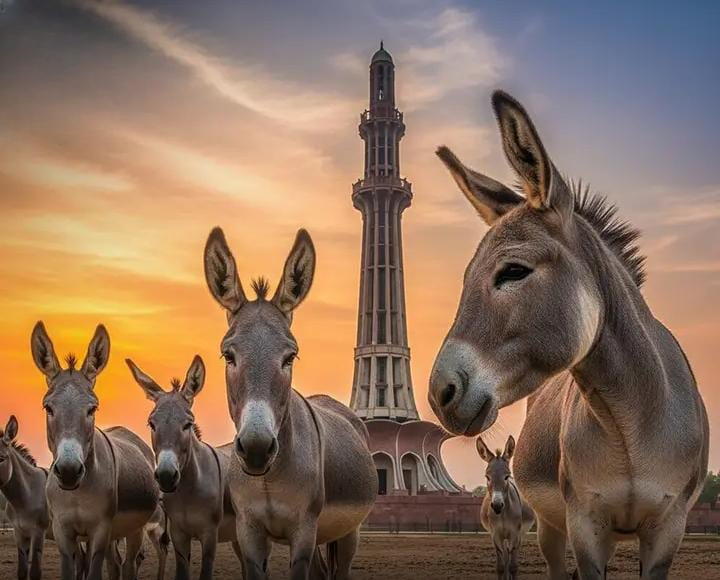A recent report by the Punjab Tops Donkey Population In Pakistan: PBS Report Reveal shighlighting both the cultural and economic role these humble animals continue to play in the daily lives of millions of Pakistanis. The data, part of the government’s annual livestock statistics, paints a fascinating picture of how donkeys remain a vital resource in rural and urban areas alike, despite the rapid modernization of transport systems.
A Steady Increase in Donkey Numbers
According to the PBS figures, the donkey population in Pakistan has shown a steady rise over the past decade. Nationally, there are now over 5.9 million donkeys, with Punjab accounting for the largest share. Experts attribute this growth to the continued reliance on donkeys for short-distance transport, goods carriage, and agricultural tasks in both rural villages and congested city centers.
Punjab’s dominance in the statistics is unsurprising to many. As the country’s most populous province and home to vast agricultural lands, Punjab depends heavily on animal-driven transport, especially in areas where motorized vehicles are either too costly or impractical due to narrow, unpaved roads.
Why Donkeys Remain Indispensable
While modern vehicles have replaced animal labor in many parts of the world, donkeys continue to thrive in Pakistan because of their adaptability, low maintenance costs, and resilience in tough conditions. They can carry heavy loads across rough terrain, require less food compared to horses or mules, and are capable of working in extreme weather conditions.
In urban areas, especially in cities like Lahore, Faisalabad, and Multan, donkey carts are a common sight, transporting everything from bricks and construction materials to vegetables and water tanks. In rural Punjab, they are used for plowing small plots, fetching water, and delivering agricultural produce to local markets.
Economic Significance
For thousands of low-income families, donkeys are not just animals — they are assets that provide daily income. A single donkey can help its owner earn by transporting goods for small businesses or households. Many families in rural areas measure their livelihood security in part by the health and productivity of their donkeys.X
Animal rights activists have pointed out that because donkeys are often owned by poorer communities, they tend to be overworked and underfed. The PBS report, while focused on numbers, has also reignited discussions about the welfare and working conditions of these animals.
Cultural Presence
Donkeys have long been part of Pakistan’s rural life and even its urban folklore. They feature in jokes, idioms, and children’s stories — sometimes humorously, sometimes symbolically — but in reality, they are among the most hardworking creatures in the country. In Punjab’s weekly livestock markets, donkey sales remain brisk, with prices depending on the animal’s age, strength, and training.
Regional Comparisons
The PBS report breaks down donkey populations province by province. After Punjab, Sindh holds the second-largest number of donkeys, followed by Khyber Pakhtunkhwa and Balochistan. While these provinces also rely on donkey labor, Punjab’s combination of high population density, extensive agricultural activity, and a network of small towns and cities has ensured it retains the largest share.
Interestingly, the growth rate in Punjab’s donkey population has been faster than the national average, suggesting that even with the rise of motorcycles, rickshaws, and small trucks, many communities still find donkey transport more cost-effective.
Challenges and Welfare Concerns
The report’s release has prompted calls from animal welfare organizations for better regulation and care of working animals. Many donkeys in Pakistan face harsh working conditions, carrying loads far beyond their capacity, often with inadequate food, water, and rest. Some NGOs have been working with communities to provide veterinary care, educate owners about proper feeding and load management, and promote humane treatment. READ NEXT https://elevenpakistan.com/pakistan-stock-market-surges-past-147000-points/
The government has also been encouraged to look into policies that can improve the welfare of working animals without hurting the livelihoods of those who depend on them. This could include subsidized veterinary services, awareness programs, and the introduction of lighter carts that reduce strain on animals.
A Symbol of Resilience
Despite their often underappreciated status, donkeys in Pakistan — especially in Punjab — symbolize resilience and endurance. They work tirelessly in fields, markets, and construction sites, playing an invisible but essential role in keeping parts of the economy moving. Their quiet contribution goes largely unnoticed in the rush of modern life, yet for countless families, they are the backbone of survival.
Looking Ahead
Livestock experts believe that the donkey population in Pakistan is unlikely to decline anytime soon. While urban infrastructure improvements and affordable motorized transport may gradually reduce reliance on donkey carts in cities, rural areas will continue to depend on them for the foreseeable future.
Some see an opportunity in this continued reliance — for example, improving breeding, health, and training standards could not only benefit the animals but also increase their efficiency and lifespan, thereby supporting the livelihoods of owners.
Conclusion
The PBS report on livestock statistics, showing Punjab’s position at the top of Pakistan’s donkey population chart, is more than just an agricultural fact. It’s a reminder of how traditional, low-cost, and environmentally friendly forms of labor remain deeply embedded in daily life. Donkeys, often overlooked and underestimated, remain steadfast partners in the journey of millions of Pakistanis, especially in Punjab, where their role is as essential today as it was generations ago.
READ MORE



